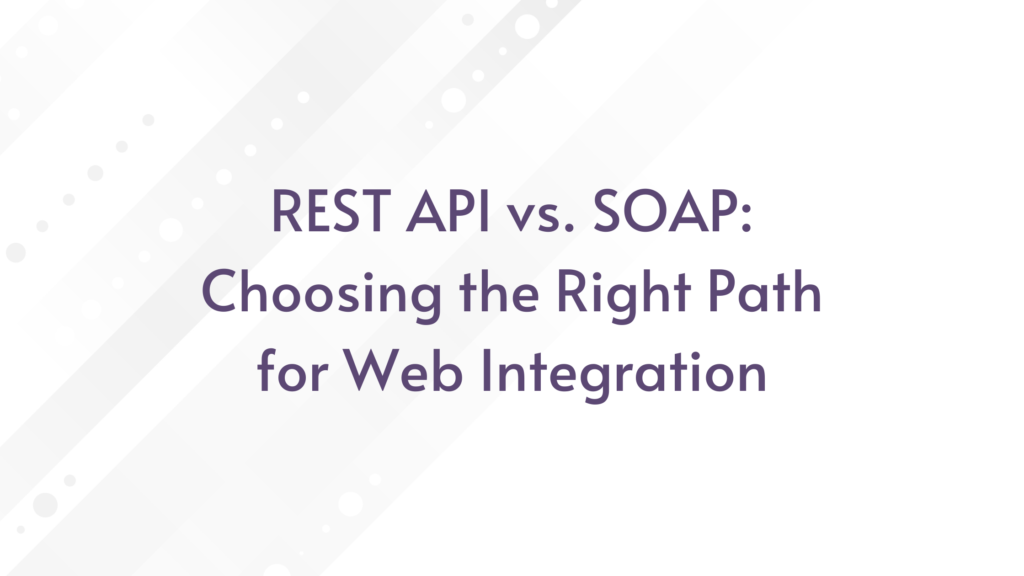Understanding REST API and SOAP: A Comprehensive Comparison

In the world of web development and software integration, two widely used communication protocols stand out: REST API and SOAP. These protocols enable applications to communicate with each other over the internet, facilitating data exchange and functionality sharing. In this blog, we will delve into the concepts of REST API and SOAP, exploring their differences, benefits, and use cases.
What is a REST API?
REST (Representational State Transfer) is an architectural style for designing networked applications. REST APIs provide a way for different software applications to communicate with each other using standard HTTP methods. These methods include GET (retrieve data), POST (create new data), PUT (update existing data), and DELETE (remove data).
Key features of REST API:
- Stateless: Each request from a client to the server must contain all the necessary information for the server to understand and process the request. The server doesn’t store any client context between requests.
- Resources: REST APIs expose resources, which are identified by URLs (Uniform Resource Locators). These resources can be manipulated using standard HTTP methods.
- Representation: Data exchanged between client and server is typically in JSON or XML format, allowing for flexibility and compatibility.
- Caching: REST APIs can utilize caching mechanisms to improve performance by storing responses for commonly requested resources.
What is SOAP?
SOAP (Simple Object Access Protocol) is a protocol for exchanging structured information in the implementation of web services. It relies on XML to define message structure and relies on various application-layer protocols to transport messages.
Key features of SOAP:
- Message Structure: SOAP messages are structured using XML, allowing for complex data types and custom structures.
- Protocol Agnostic: SOAP messages can be transported over various protocols, including HTTP, SMTP, and more.
- Stateful: SOAP maintains the state of the application between requests, which can be beneficial for certain use cases but may lead to more complex implementations.
- Security: SOAP has built-in security features like WS-Security, which enable encryption and authentication of messages.
REST API vs. SOAP: A Detailed Comparison
| Aspect | REST API | SOAP |
| Architectural Style | Representational State Transfer | Simple Object Access Protocol |
| Message Format | JSON or XML | XML |
| Communication | Uses standard HTTP methods (GET, POST, etc.) | Uses XML-based messaging protocol |
| State Management | Stateless | Stateful (maintains application state) |
| Complexity | Simpler, easy to implement | More complex, requires detailed specifications |
| Flexibility | Lightweight, suitable for mobile and web | Suited for enterprise-level applications |
| Performance | Generally faster due to lightweight nature | May have higher overhead due to XML parsing |
| Caching | Supports caching for improved performance | Caching requires more configuration |
| Security | Relies on underlying transport security | Built-in security features (WS-Security) |
| Error Handling | Uses standard HTTP status codes | Detailed fault codes and error handling |
| Scalability | Highly scalable | May require additional measures for scaling |
| Use Cases | Mobile apps, web apps, APIs for external apps | Enterprise-level applications, legacy systems |
Conclusion
In the realm of web services, both REST API and SOAP play crucial roles in enabling communication between applications. While REST API offers simplicity, speed, and compatibility with modern web and mobile applications, SOAP provides a robust solution with built-in security features and advanced data structure support. The choice between REST API and SOAP largely depends on your project’s requirements, security considerations, and existing infrastructure. By understanding the strengths and weaknesses of each approach, you can make an informed decision that aligns with your development goals.

Leave a Reply